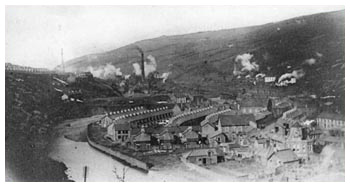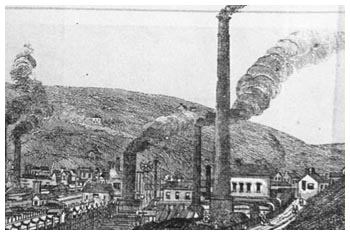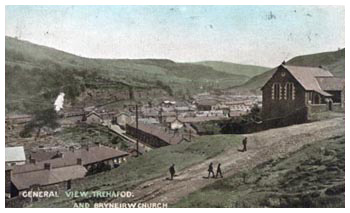
| Trehafod | |
 |
He township of Trehafod lies on the border between the Rhondda and Taff Ely, or as the 1926 Kelly's Industrial Directory describes it as being ‘partly in the Parish of Pontypridd and partly Ystradyfodwg' The 1847 tithe map of the area shows a number of farms on the area that was to become Trehafod, these were named, Hafod Uchaf, Hafod Genol and Hafod Fawr. It was from these farms that Trehafod was to take its name. Hafod is a Welsh word that can mean both, a summer dwelling or upland farm. The mineral rights of these lands were first leased as early as 1809. In addition to these farms the 1847 tithe map also shows a single cottage in the area and a tramroad and railway. |
| It was this accessibility to this lower part of the Valley that provided the impetus for the earliest mining exploration in this area. As such, pre-1850 a number of small levels and shallow pits were sunk here to the bituminous coal levels for the small, but expanding ‘sale coal' markets. Thus in 1809 Jeremiah Homfrey opened the first Hafod Level, and in 1835 William Crawshay opened the Gwaun Yr Eirw level nearby. The first workers were predominantly ex agricultural labourers from the surrounding countryside. Then in 1850 Edward Mills sank the Coedcae Colliery and two brothers David and John Thomas sank the Hafod Colliery. | |
However these were small concerns, and the Coedcae and Hafod Collieries suffered major problems. It was with the subsequent purchase of these concerns by W.T. Lewis, later Lord Merthyr, and the sinking of the Trefor and Bertie pits across the river that Trehafod as a major coal producer really came into being. Although Lewis continued to mine bituminous coal from the Coedcae Pit, under the name of Coad Cae Coal Company, it was the sinking of the Hafod, Trefor and Bertie pits to the rich steam coal measures that made Trehafod. These three steam coal pits became, ‘the nucleus of one of the greatest mining concerns in Britain', employing at its peak nearly 5,000 men and producing nearly one million tons of coal annually. |
Hafod and Coedcae Collieries |
Bryn Eirw Mission/Church |
In common with most mining villages Trehafod boasted its own church, Saint Barnabus' originally Bryn Eirw Mission, chapels including Welsh Baptist, Calvinistic, Welsh Congregational and Wesleyan. |

